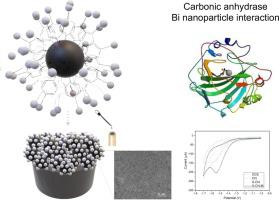Applied Surface Science ( IF 6.3 ) Pub Date : 2023-05-29 , DOI: 10.1016/j.apsusc.2023.157636 D. Vieira , E. Harvey , G. Merle

|
An increasing number of metalloproteins has shown to play essential roles in physiological processes. The Zn(II)-dependent metalloprotein, carbonic anhydrase (CA), is a hallmark of metabolic change in cancer cells. Being able to evaluate CA expression is crucial for the early detection of malignant tissues. The fabrication of sensor based on bismuth nanomaterials tethered on mesoporous carbon through a conductive spacer arm is reported. By coupling this hybrid material with stripping analysis, its functionality in measuring CA levels in body fluids is validated. Notably, the zinc finger metalloprotein biosensor system successfully and reliably tunnels zinc within the protein shell allowing the detection of increased concentrations of metalloproteins in saliva. The sensor displays high specificity, sensitivity, repeatability, and most of all a limit of detection of 4.8 ng·ml−1 for zinc ions and 11 ng·ml -1 for CA metalloprotein. Given the clinical significance of carbonic anhydrase in tumour development, these findings are the first step towards fast, low cost and stable sensor technology and will revolutionize the field of cancer diagnosis.
中文翻译:

用束缚在碳表面的铋纳米材料剥离金属蛋白
越来越多的金属蛋白已被证明在生理过程中发挥着重要作用。Zn(II) 依赖性金属蛋白碳酸酐酶(CA) 是癌细胞代谢变化的标志。能够评估 CA 表达对于恶性组织的早期检测至关重要。据报道,基于通过导电间隔臂束缚在介孔碳上的铋纳米材料的传感器的制造。通过耦合这种混合材料通过剥离分析,其测量体液中 CA 水平的功能得到了验证。值得注意的是,锌指金属蛋白生物传感器系统成功且可靠地在蛋白质壳内输送锌,从而能够检测唾液中金属蛋白浓度的增加。该传感器表现出高特异性、灵敏度、重复性,最重要的是锌离子的检测限为4.8 ng·ml -1 , CA金属蛋白的检测限为11 ng·ml -1 。鉴于碳酸酐酶在肿瘤发展中的临床意义,这些发现是迈向快速、低成本和稳定传感器技术的第一步,并将彻底改变癌症诊断领域。











































 京公网安备 11010802027423号
京公网安备 11010802027423号